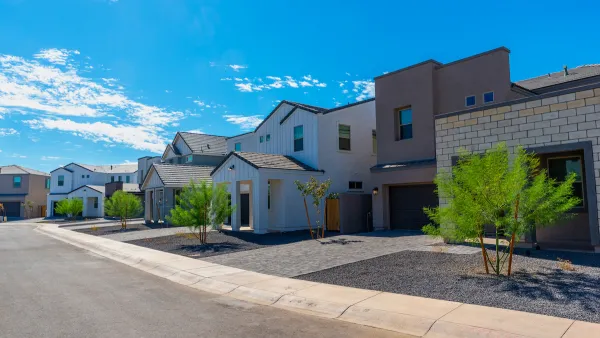Municipal setback requirements inconvenience pedestrians for no good reason.
Municipal zoning codes and comprehensive plans often require buildings to be set back far from the street. As a result, the metropolitan landscape sometimes looks like one giant strip mall; every building is separated from the street either by a parking lot or by some form of greenspace.
These rules inconvenience pedestrians in a variety of ways. First, setbacks artificially reduce density by reducing the amount of land available for housing and jobs. Since good transit service requires a minimal level of density (at least five units per acre for hourly bus service, and more for higher-quality bus service or rail), lower density means less transit service. Second, setbacks also force pedestrians to spend more time walking between buildings and sidewalks, thus making their commutes longer and more inconvenient. Third, setbacks make pedestrians feel less enclosed, making walking a less pleasant experience.
So why do cities still have these rules? Seattle's comprehensive plan makes a variety of arguments for mandatory setbacks. First, the plan claims that setbacks "ensure access to light and air." But all human beings breathe air no matter where buildings are placed, so "air" is irrelevant. Access to "light" also exists no matter where buildings are placed (with the possible exception of very tall buildings* that might cast shadows).
The plan also claims that setbacks create a "sense of privacy." This argument is so subjective that it is immune to verification. Having said that, I have lived in buildings that are near the sidewalk and those that are not, and I don't feel like I have any less privacy in the first situation.
Finally, the city claims that setbacks "provide adequate transition between zones of different intensities." This argument would justify setbacks for buildings at the border of two zones, but not for other buildings.
In sum, all of the city's arguments for setbacks appear to me to be unpersuasive.
*Living in midtown Manhattan, I notice that even streets occupied by very tall buildings (like Avenue of the Americas) sometimes have ample sunlight, depending on the time of the day and the side of the street at issue. So even in the "worst case scenario" of a skyscraper-dominated street, it is not true that buildings that front the sidewalk reduce sunlight.

Analysis: Cybertruck Fatality Rate Far Exceeds That of Ford Pinto
The Tesla Cybertruck was recalled seven times last year.

National Parks Layoffs Will Cause Communities to Lose Billions
Thousands of essential park workers were laid off this week, just before the busy spring break season.

Retro-silient?: America’s First “Eco-burb,” The Woodlands Turns 50
A master-planned community north of Houston offers lessons on green infrastructure and resilient design, but falls short of its founder’s lofty affordability and walkability goals.

Test News Post 1
This is a summary

Analysis: Cybertruck Fatality Rate Far Exceeds That of Ford Pinto
The Tesla Cybertruck was recalled seven times last year.

Test News Headline 46
Test for the image on the front page.
Urban Design for Planners 1: Software Tools
This six-course series explores essential urban design concepts using open source software and equips planners with the tools they need to participate fully in the urban design process.
Planning for Universal Design
Learn the tools for implementing Universal Design in planning regulations.
EMC Planning Group, Inc.
Planetizen
Planetizen
Mpact (formerly Rail~Volution)
Great Falls Development Authority, Inc.
HUDs Office of Policy Development and Research
NYU Wagner Graduate School of Public Service




























